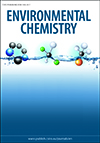Environmental context. Specific inhibitors of biological reactions in the nitrogen cycle can be used to determine the origin of reactive nitrogen species; these nitrogen species potentially degrade water quality or influence climate. However, inhibitors can potentially interfere with methods for the analysis of stable isotope ratios and concentrations of ammonium, nitrite and nitrate. The effect of this interference on several commonly used methods was investigated. These findings should help avoid the use of inappropriate analytical methods and improve data quality in studies of the nitrogen cycle.
EN21118 Abstract | EN21118 Full Text | EN21118PDF (417 KB) Open Access Article





